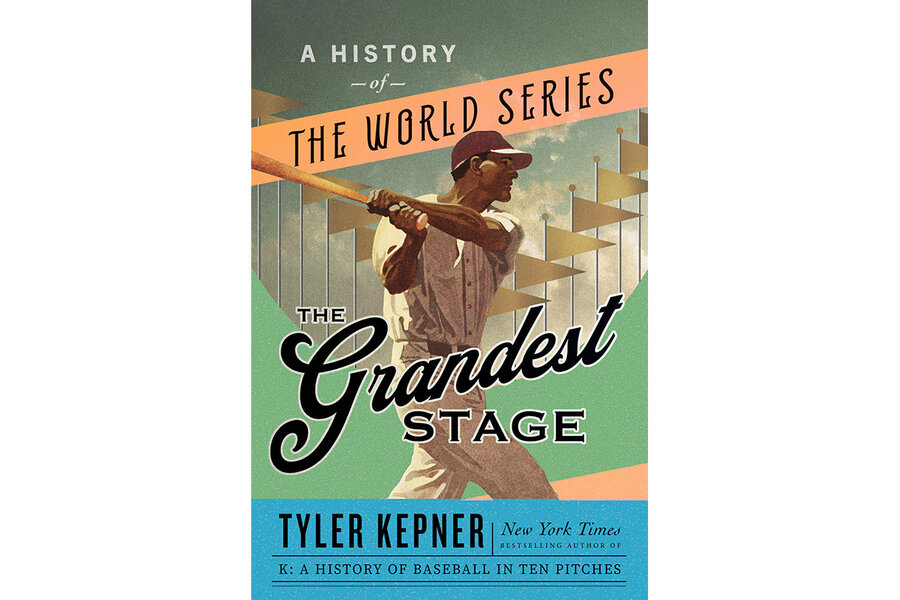Baseball columnist Tyler Kepner sets up a history of the World Series
Loading...
For baseball fans, “the most wonderful time of year” happens long before Christmas. It’s the end of October, when the nearly 120-year-old World Series, Major League Baseball’s championship showdown, takes place. Just in time for its return, Tyler Kepner, baseball columnist for The New York Times and author of “K: A History of Baseball in Ten Pitches,” has penned a fresh take on the event, “The Grandest Stage: A History of the World Series.” He tells fascinating stories of notable and overlooked moments that helped make this contest a North American institution.
“Baseball takes time to reveal its truths,” writes Kepner, a lifelong fan of the game. He points out, when comparing the steadfast value of America’s pastime to the growing popularity of football, that the measured, deliberate pace of the seven game series is its charm:
“Baseball is a fundamentally different product, an everyday companion for seven months, not a once-per-week spectacle for five. Americans spend countless more hours watching baseball, which has about 10 times as many games, than they do watching football, in person and at home. A Super Bowl lasts less than four hours; a World Series might go 25. And what a treat that is for the millions of us who love baseball. Every season is an inverted pyramid, contenders whittled away as the schedule descends to that delicious denouement, in four to seven acts, beginning in late October.”
Kepner paints baseball as a Homeric epic in contrast to the slam poetry of football – both powerful, but in their own ways. In “The Grandest Stage,” he invites all sports lovers to reawaken an appreciation for the long-form championship by looking back on a delightful hodgepodge of stories in World Series history that reveal the distinctive theater of baseball.
He’s careful not to call his book a definitive or chronological history, but rather, as the book’s subtitle suggests, “a history.” There are no game-by-game breakdowns or lengthy profiles of famous players. Instead, Kepner intentionally divides the book into seven sections, each focused on a narrow theme, to examine the Series in a novel way.
There are tales detailing how players handled the pressures of the series as well as myth-shattering stories. The fascinating role of managers is examined, as are the arcs of unsung heroes as well as those of players who committed now-forgotten gaffes. “I tried not to cover the same old ground,” Kepner writes in his acknowledgments, and readers will find he succeeds in providing new perspectives while telling engaging and occasionally eyebrow-raising stories.
Big names and moments get their mention: Kepner details how Babe Ruth’s famous prediction of where he would slam a homer in the 1932 series was likely a case of revisionist history and argues that the 1919 White Sox allegedly throwing the Series barely mattered since their opponents, the Cincinnati Reds, were simply the better team that year.
But far more frequently in the book, it’s the lesser-known players and pieces of history that get the spotlight. A whole chapter is given over to players who were never the best on the roster, but who made an impact in pivotal points of the Series, like Geoff Blum, whose clutch home run in the 14th inning of 2005’s Game 3 clinched the win for the White Sox in what was the longest World Series game to date.
By highlighting the more obscure topics, Kepner assumes at least a working knowledge of the Series’ history on the part of the reader. The structure of the second chapter, “Game 2,” which breaks down some so-called “Sidebars,” or obscure truths, makes this presumption plain. Kepner is after the behind-the-scenes deeper cut, what fans might not know about particular games or players.
“The Grandest Stage” is not exactly a book for baseball neophytes, but it is a quirky and engrossing celebration of the Series. Throughout, Kepner’s love of the game is infectious. His passion and experience as a sports columnist come together to make each story lively and compelling. Reading “The Grandest Stage,” bouncing from story to story, feels like having an all-night-long chat with a fellow baseball-obsessed friend.








